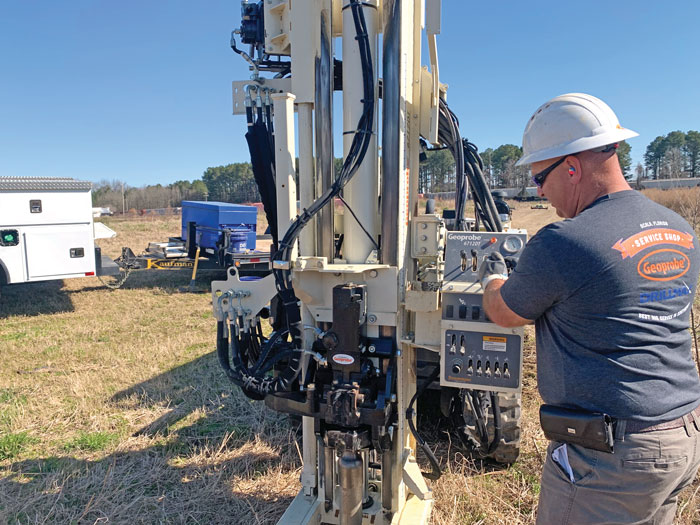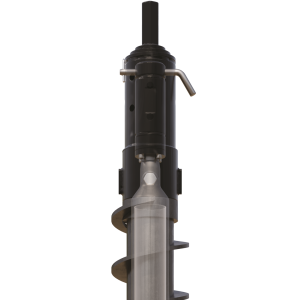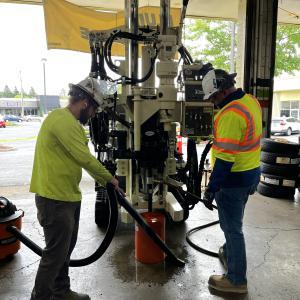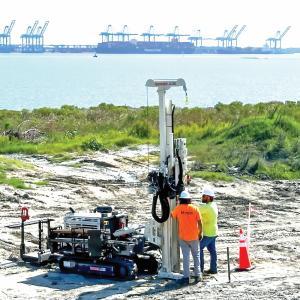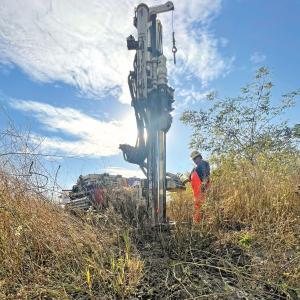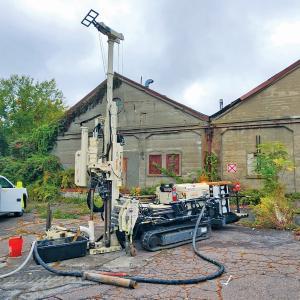PFAS Contamination
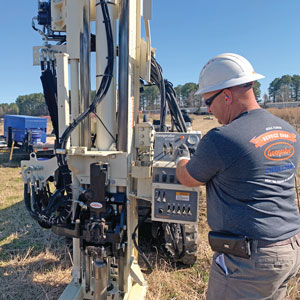
PFAS Sampling Protocols and Issues
PFAS compounds have “emerged” as a significant contaminant of concern all across the nation. These polyfluorinated alkyl substances have been used in many industrial and commercial products and applications. Unfortunately, this means they have contaminated the soil and groundwater at many locations. Because of the very strong bonds between the fluorine and carbon atoms in these compounds, they are nearly indestructible (persistent) and their high solubility allows them to readily migrate in groundwater.
What are PFAS?
PFAS consist of a large group of fluorinated polymers used in many commercial and industrial products. This includes any of the Teflon® polymers used in common household products like your frying pan, PTFE plumber’s tape, your Goretex-lined rain coat, or the water/stain resistant coating on your carpet or couch. One of the primary concerns for these polymers relates to Aqueous Fire Fighting Foams (known as AFFF, AF3, or A triple F). The Department of Defense (DOD) has used these foams to fight/control fires at air bases and also used in fire training. Many commercial airports and some municipal fire departments have also used AFFF. These fire-fighting foams contain several of the PFAS polymers, including PFOA and PFOS.
EPA PFAS Contamination Guidelines
The Federal Environmental Protection Agency (EPA) has set a Health Advisory Level for PFOA + PFOS at 70 parts per trillion – yes, 70 parts per trillion or 70ng/l for drinking water. Currently labs are using analytical methods (LC/MS/MS) that can detect many PFAS compounds at the 2ppt to 5ppt levels, this is about 1000 X below levels we have been concerned with before for environmental sampling. These very low action levels and PFAS contamination detection levels combined with the widespread use of PFAS compounds in many commercial products means there are significant concerns with potential cross contamination of samples. To give an example, there were concerns that anything with a Teflon® component or containing Teflon® tape or sealants may cause detectable PFAS cross contamination. Also, anything coated to be water or oil resistant (e.g. your water proof rain coat, the carpet in your house, the wrapper on the burger you had for lunch, the pizza box) probably contains detectable PFAS compounds (see Denly et al. 2019 and Rodowa et al. 2020).
Geoprobe® Sampler Analysis
Geoprobe® submitted samples of our clear PVC soil liners, including the lay flat liners used for sonic soil sampling, to Jennifer Field, Ph.D., at Oregon State University and her research team. Field’s team analyzed the Geoprobe® soil liners for 52 PFAS compounds, including PFOS and PFOA. The PVC liners tested nondetect for all 52 compounds. The research concluded that field sampling materials are an unlikely source of PFAS contamination for Perfluoroalkyl and Polyfluoroalkyl substances in field samples.
Geoprobe® tested groundwater sampling tools and systems, including the Hydraulic Profiling Tool (HPT) system, the 175GWP groundwater profiling system, the Screenpoint16 (SP16) and Screenpoint22 (SP22) groundwater samplers, and the prepacked screens used in many direct push installed monitoring wells. All of the systems tested were found to be nondetect for each of the 36 PFAS compounds on the Wisconsin PFAS analyte list. PFAS Technical Bulletins providing a detailed review of the equipment tested, procedures used, and lab report can be downloaded from our website.
- Hydraulic Profiling Tool (HPT)
- 175GWP (groundwater profiler)
- SP16 & SP22 groundwater samplers
- Prepack well screens
Latching Samplers Assure Sample Integrity
Geoprobe® Screen Point (SP) Groundwater Samplers are a mainstay of contaminant site investigations. This tool has become standard equipment for direct push operators since its introduction in the 1990s. The magic of the SP system is its ability to deliver a protected sampling screen to depth and then to “open” or expose that screen to the formation. Improving field performance, particularly when sampling for PFAS contamination, Geoprobe® has developed groundwater screen point (SP) latching samplers. These enhancements to the time-tested Geoprobe® SP groundwater sampling system provide a secure seal within the zone you're pumping, allowing you to use a mechanical bladder pump or other sample line to obtain a higher-quality sample. Options available in three sizes: SP16, SP19 and SP22.
PFAS Sampling Recommendations
Geoprobe® recommends you conduct periodic field rinsate samples of tools and soil liners during your PFAS sampling projects. You must use PFAS free water provided by your laboratory for this purpose. Tap water or bottled water may have been in contact with PFAS containing materials such as Teflon® tape or PTFE containing pipe joint compound. Of course, use bottles (HDPE or Polypropylene) provided by your lab for the PFAS field rinsate samples.
The steel components of soil samplers and groundwater sampling tools do not contain PFAS compounds. Use of these tools for PFAS sampling and investigation following standard procedures is appropriate. Be careful to NOT use materials like Teflon® tape or PTFE joint compound on joints or fittings that will have sample contact. Don’t use Teflon® soil liners or tubing in your sampling for PFAS contamination. Use the clear PVC soil liners when soil sampling or HDPE or polypropylene tubing when groundwater sampling. The DOD has recommended the use of silicon-based plumbers paste and O-rings in place of Teflon® products. Also, the DECON 90 product contains PFAS components so use decon soap and water approved for PFAS sampling. We are all coming up the PFAS contamination learning curve. As the entire industry continues to learn about PFAS sampling, analysis, and remediation, updates and revisions to guidance documents and operating procedures will be issued.
Contact Us
1835 Wall Street
Salina, Kansas 67401
Phone: (785) 825-1842
Everything has to be clean and you’re constantly changing out gloves. You have to be very detail oriented and realize that many products we use or wear may have PFAS in it — you need to be very aware of cross contamination,
Jeff Grant, Owner, JG Drilling
Related Articles
The 4.25 HSA Continuous Sampler is versatile and easy to use when collecting large sample volumes.
ID: 14619 | Date:
6011DT’s compact design and GH63 hammer let you reach depth in tight-access sites.
ID: 14615 | Date:
6712DT delivers the power and agility needed for injection point projects.
ID: 14614 | Date:
Geoprobe® international service expertise keeps the 7822DT working in the field, not sidelined in the shop.
ID: 14613 | Date:
Pullback power of 7822DT outperforms conventional rigs, overcoming sand friction when driving 4-inch casing.
ID: 14608 | Date:
Related Videos
ID: 14189
Geoprobe® Sonic Drilling Products
ID: 14188
ID: 13740
3230DT Walkaround - Control Panel
ID: 13627
ID: 13626
ID: 12726
ID: 1909
Behind the Design - Macro-Core®
ID: 6668
ID: 5732
Depend on Team Geoprobe®
Since 1987, Geoprobe® has manufactured innovative drilling rigs and tooling - engineered for efficiency and safety - simplifying drillers’ jobs and empowering their companies to succeed as productive and profitable leaders in the industry. When you partner with Geoprobe® you receive:
Customer-inspired Innovation
Engineering and building industry-leading drilling rigs, tooling, and techniques for the technical driller based on your needs to work safer and more efficiently.
Exceptional Value
Ensuring drilling rigs and tooling are created in conjunction – with consistent quality – to collect the highest-quality information with the most accurate result to get you to, into, and through the job efficiently.
Superior Service
Equipping you to do your best job and keeping you in the field via one-on-one expert sales and service technicians manning live support phone lines, shipping necessary parts same-day.


